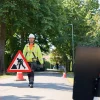South Western Railways Goes Live with 5G for Superfast Onboard WiFi

A few years have passed since the South Western Railway (SWR) announced that it would deploy a new rail-side 5G mast network (here), which aimed to deliver “superfast” onboard WiFi for people travelling on a 70km long stretch of their Main Line into London (between Basingstoke and Earlsfield). But after some delays, the new network is now live.
The original announcement, which involved the roll-out of a “Rail-5G” solution (i.e. special track-side 5G mobile / radio pole masts that are used to supply data capacity for onboard WiFi), envisaged the new network – backed by FirstGroup’s rail division – as being completed during “early 2023“. But clearly it ended up taking a bit longer than that to deliver.
According to the latest update, customers can on that stretch of line can now enjoy “unprecedented internet speeds up to 20 times faster than the current average“, as it becomes the “first train operator in Europe to introduce rail-5G Wi-Fi” (we have seen other train operators using similar solutions before). But that reference to “20 times faster” should perhaps be taken in context of SWR’s previously quite flaky onboard WiFi (speaking from personal experience).
Advertisement
On the other hand, SWR did previously trial the solution on the Isle of Wight, which is said to have been able to “consistently deliver” broadband speeds (throughput) of 1Gbps to a moving train (i.e. shared capacity for commuters and the train operator). The new Rail-5G network is separately described as being a “multi-gigabit internet solution“.
Peter Williams, Customer and Commercial Director for SWR, said:
“We’re thrilled that our customers travelling between Earlsfield and Basingstoke are the first to benefit from this unprecedented superfast Wi-Fi.
Customers can now stream, download files, video call, and much more – without worrying about their connection.
Whether travelling for work or leisure, having access to a strong and reliable internet connection will make their time on board more productive and enjoyable.
We hope this will make travelling by train an even more attractive option, helping to get people out of cars and onto the rail network.”
SWR highlights how polling conducted by Ipsos found that 41% of UK adults would be more likely to consider taking the train over other modes of transport if train companies provided fast, reliable on-board Wi-Fi. The figure is even higher among younger people, rising to 64% of those aged 16-24 and 59% of those aged 25-34.
Mark is a professional technology writer, IT consultant and computer engineer from Dorset (England), he also founded ISPreview in 1999 and enjoys analysing the latest telecoms and broadband developments. Find me on X (Twitter), Mastodon, Facebook, BlueSky, Threads.net and Linkedin.
« Rural Broadband ISP Wildanet to Retire Fixed Wireless Network























































Really good new story and pleased that they have taken this approach.
It really is the most efficient way of providing connectivity on train gigabit backhauled WiFi via private 5G rather than trying to provide public 5G direct to every user on a fast moving train.
There is nothing worse than being in a train carriage where dozens of people are trying to create their own WiFi network by tethering their laptop to their phone with everyone trying to compete for the same WiFi channels including choking the on board WiFi of spectrum, while they all jump from one public cell site another.
You make a fair point. I had in the past been somewhat dismissive of on-train WiFi, probably because it often wasn’t all that good, and thought that better 4G & 5G coverage was the answer. But actually having powerful centralised transceivers on the train to lock onto trackside 5G masts is going to deliver a better experience (as long as all the kit is operative!).
I’m less convinced it’s necessary for metro and suburban routes where the trains are slower and stopping more often travelling through areas that should (ideally) have decent mobile coveage, but for faster trains through less populated areas it seems a good concept.
Who owns this network now that SWR has passed into state ownership? Who is paying for the “free” service?
The passengers are paying for it within their ticket price. Just like they are paying for the seat inside the carriage irrespective of whether they sit or stand.
Does this mean that train tracks in the future will have a whole separate track for passing 5G?
Great… for travel from Basingstoke up to London. But the SWR routes the other way, to the south and west, have significant patches of patchy or non-existent mobile reception (not just in tunnels and cuttings, and I think this applies to all the networks to a degree) – so until this rolls out further, the on-train WiFi beyond Basingstoke may well remain somewhat flaky.
The capacity of the train in the photo has 359 seats – it’d have to be faster than 1Gbps to give even half of those a decent connection.
You forget about contention and diversity. Most passengers won’t be continually hammering the WiFi on their device(s). 1 Gbps is enough for nearly everyone to be streaming Netflix in high definition, and that’s without sneaky tricks like on-train content caches.